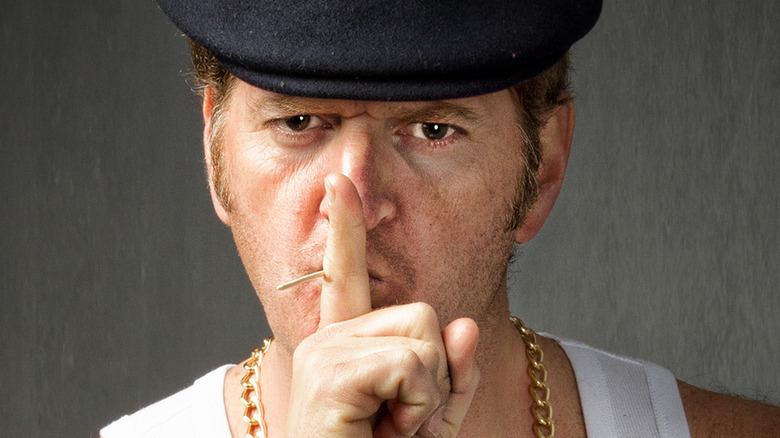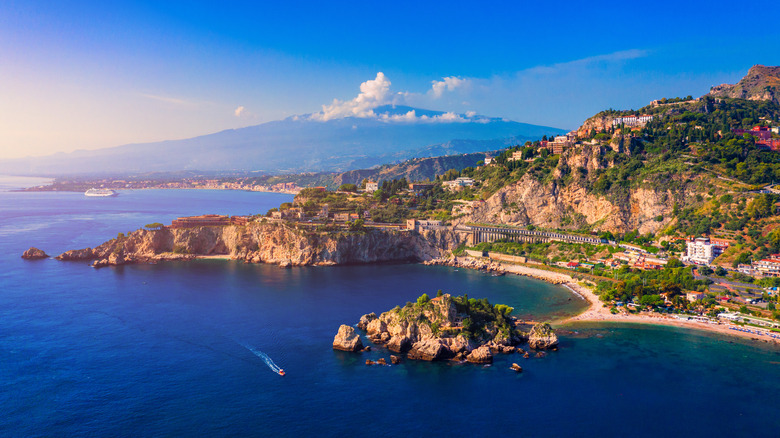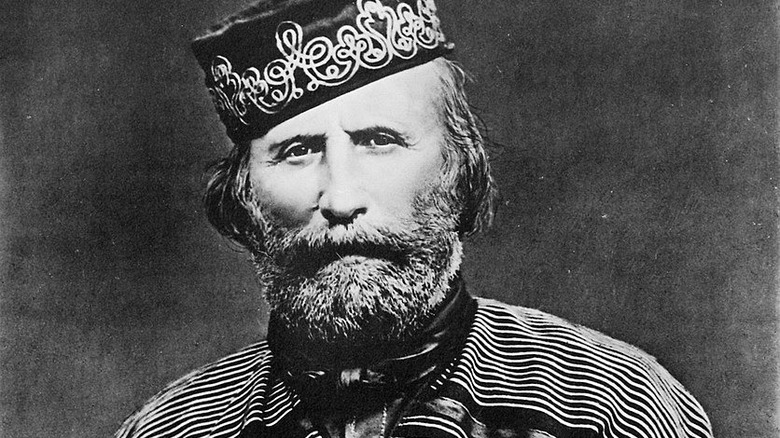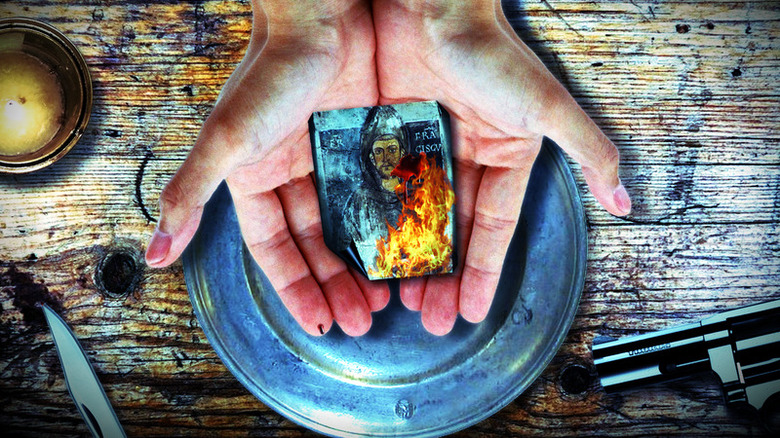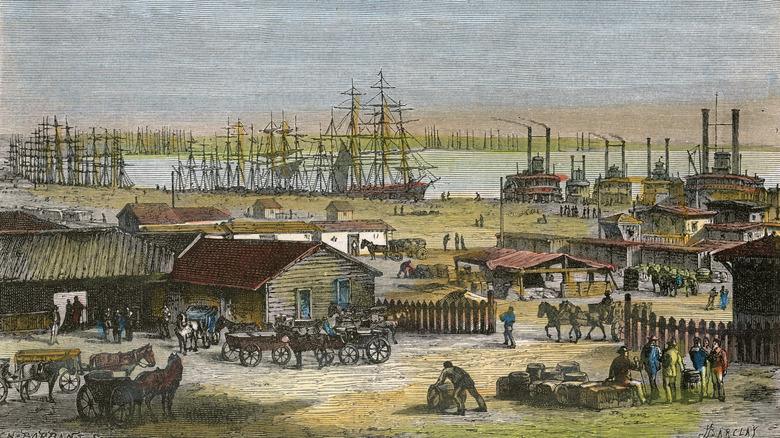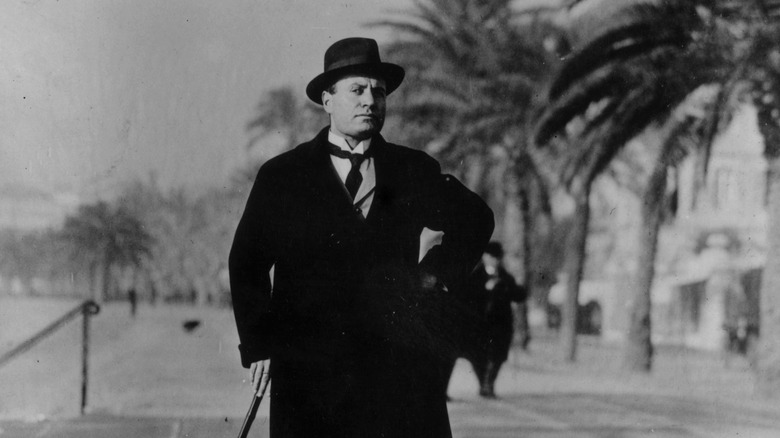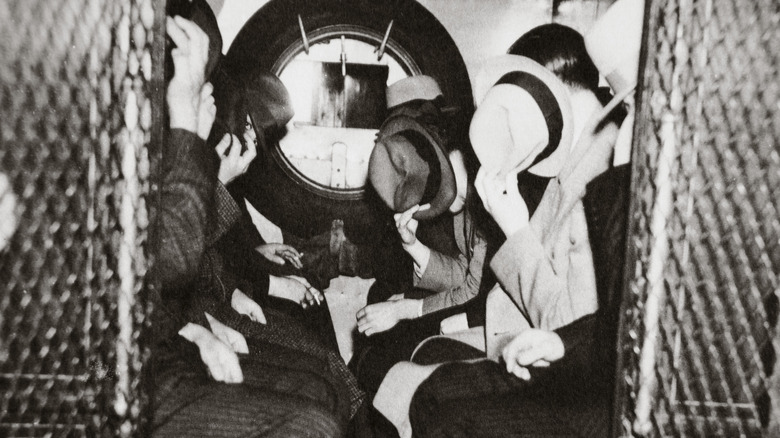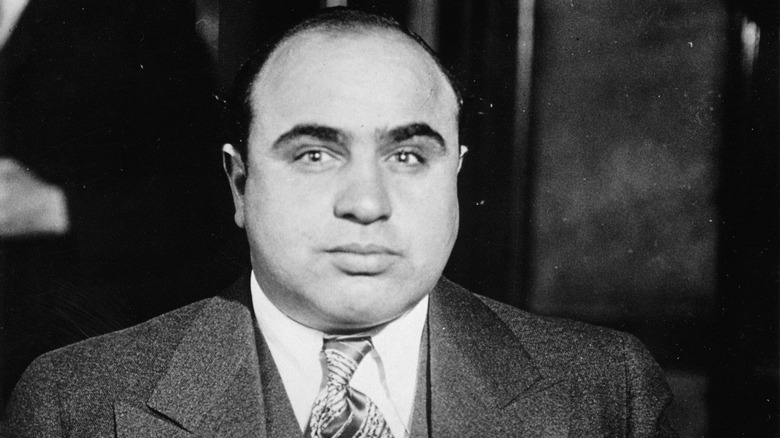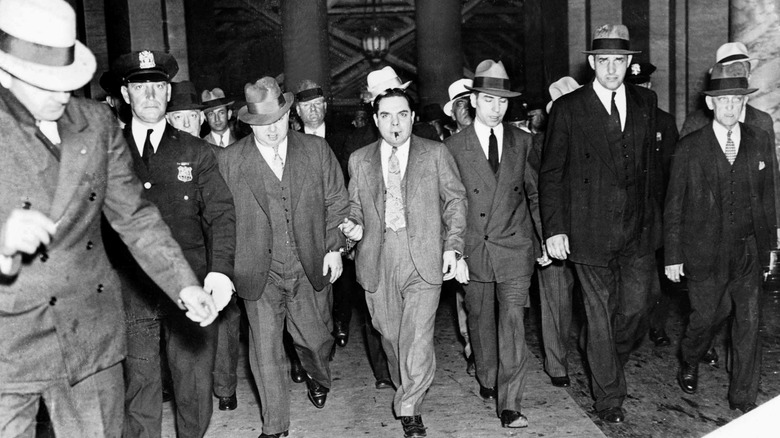This Is How The Mafia Got Started
From "The Godfather" trilogy to "The Sopranos" and beyond, popular culture has a long-held fascination with the Mafia. Part of the fascination behind this world of crime, and why it's so captivating onscreen, is its contradictions, particularly its moral ambiguity and twisted sense of loyalty. After all, the law-breaking and violence involved in the Mafia seems surprising for an organization whose members tend to value family and Catholicism highly.
The history of the Mafia is similarly complex and ambiguous. The roots of the Italian Mafia can be traced back to the cultural background of the country's southern island of Sicily, but much of the history that followed — including the dawn of the United States Mafia — is a complex tale of deadly fights for power, seized opportunities to expand criminal operations, and influence gained through imitation and bribery. Here's how the Mafia got started and grew into an international force to be reckoned with.
Sicily has a long history of hostile takeovers and power grabs
Around 750 BC, the Ancient Greeks began colonizing the island of Naxos and much of southern Italy, according to Sicily 4 U. Although Greek influence still remains visible in Sicily, the group's grip on the region was hard-won and relatively short-lived. The Ancient Greeks were one of many groups who would be a part of Sicily's long history of bitter power struggles. Not only did the Carthaginians swiftly seize power, but there were also rivalries between different settlements within the Ancient Greek community.
A few centuries later, Sicily was taken over by the corrupt Roman empire, which ruled over the land for 500 years. The Roman rule wasn't all bad, as it led the island's resources to flourish. Still, the hostile history of Sicily continued, as it was invaded by the Germanic Byzantines, Ostrogoths, and Vandals around 300 AD. About 500 years later, the land continued to flourish as Arabs ruled and nurtured it. Then, around 1000 AD, the Normans invaded and conquered the region and made way for more harmonious relationships between various religious and ethnic groups. Still, rivalries would continue to infiltrate the island of Sicily.
Through these centuries of hostile takeovers, the Sicilian people formed regional groups, or "families," to protect themselves, per History. Over time, these clans formed their own justice systems and gradually grew into more forceful army units known as "mafie." These armies began extorting money from Sicilian landowners in exchange for protection from chaotic forces, thus infusing their "mafie" groups with criminal agendas.
The word 'mafia' has multiple layers of meaning
Although the word "mafia" has clear connotations in today's world, its etymology is hardly straightforward. According to Henner Hess's 1998 book "Mafia & Mafiosi: Origin, Power and Myth," the Florentine dialect associates the word with poverty and misery, while the Piedmontese word "mafiun" describes a petty person. Some historians believe that the word has its roots in the word "mahias," an Arabic slang word meaning "boldness" that was used while Arabs reigned over Sicily following the fall of the Roman empire. The word "Maffia" was also used in a 1658 list of heretics as a synonym for "boldness, ambition, and arrogance" in describing a witch.
"Boldness" was the primary meaning of the word until the 1860 Unification of Italy, when the Saracen Tribe of Palermo used a group of caves known as the "mafie" to hide from General Garibaldi (pictured), who deemed the tribespeople "mafiosi." In 1862, a play titled "I Mafiosi della Vicaria" became popular on the island of Sicily and mainland Italy, according to the University of Michigan. The play centered around a group of imprisoned men who planned crimes while behind bars. This organized crime was referred to in the play as "Mafia," which popularized the term throughout Europe. By 1865, even the police were using the phrase "delitto di mafia" to refer to men who planned crimes but had others carry them out, according to Hess.
The mafia got involved with some of Italy's most powerful entities
Although the 1860 Unification of Italy essentially created the country as it is now known, it also sparked a new era of chaos across the land. According to Sicily 4 U, Palermo revolted against Italy in 1866, and the Italian navy retaliated by bombing the city. Italian soldiers ultimately executed the armed rebels and regained control of Sicily, but years of colonization and rebellions left many Sicilians living in poverty.
Throughout the late 1800s, the Mafia ultimately gained power, money, and immunity through alliances with some of the most powerful groups in Italy. In the 1870s, government officials in Rome enlisted the help of the Sicilian Mafia in tracking down other, more dangerous criminal groups, in exchange for allowing the Mafia to continue exploiting local landowners without criminal penalty, per History. Making arrangements with government officials served as a gateway for the clans' involvement with a corrupt political system, and before long they were scaring the public into voting for candidates that were on their side. The clans even got involved with the Catholic Church, which enlisted them to oversee its Sicilian properties and landowners.
The Mafia is governed by a strict conduct code
The Mafia has always been ruled by a complicated system of moral rules. Although committing crimes, and often violent ones, is essential to being in the Mafia, another — and perhaps even more important — component is loyalty to fellow clan members.
According to History, blood was a prerequisite for joining the Mafia in the sense that prospective members had to have Italian heritage, but also in the sense that they often had to commit a murder in order to become a "made man." Blood also played a role in the traditional Mafia initiation ceremony, which required new members to prick their finger to draw blood while holding a burning photograph of a Catholic saint and taking a secret oath to remain loyal to the group. This loyalty included never physically assaulting another Mafia member and never getting involved with another member's romantic partner.
The Mafia governing force was traditionally a code of conduct based on the principle of omerta, which meant members could absolutely never contact police or government authorities under any circumstances. This included never seeking justice by reporting any crimes that were done to oneself or fellow Mafia members, per Britannica. Instead, the Mafia took justice and vengeance into their own hands.
New Orleans was a Mafia hotspot in the late 1800s
By the late 1800s, following the Unification of Italy, many Sicilians were left in poverty and decided to move to the United States. According to the Federal Bureau of Investigation, the first Sicilian Mafia member to move to the U.S. was Giuseppe Esposito, who fled Sicily after taking part in the murder of a chancellor, a vice chancellor, and 11 wealthy landowners on the island. In 1881, The New York Times reported that Esposito had been arrested in New Orleans and brought to New York City in handcuffs. In court, he claimed he was a simple fruit vendor named Vincenzo Rebello. He was ultimately charged with "murder, robbery, and other crimes" and extradited back to Italy.
On October 15, 1890, New Orleans' police superintendent was murdered and hundreds of Sicilians living in the area were arrested on suspicion of committing the murder, per the FBI. The 19 that were indicted were acquitted, but rumors that the acquittal was the result of bribery and intimidation spread through the streets of the Big Easy. Furious New Orleans residents organized a lynch mob, shot nine of the defendants, and hung two others.
A Mafia crime syndicate called the Sicilian Black Hand also played a prominent role in New Orleans in the late 1800s and early 1900s. According to The Mob Museum, the Black Hand was founded by Charles and Antonio Matranga around 1870. The group got involved in New Orleans rackets including drug and sex trafficking, gambling, and bootlegging, and remained powerful for decades.
Mussolini cracked down on the Mafia in 1920s Italy
Benito Mussolini was the first Italian prime minister to venture to the island of Sicily. In 1937, he made his second voyage to the island, aiming to repackage it as the central hub of the Mediterranean empire because, he said, Sicily was "Fascist to the bone-marrow" (via The Journal of Modern History). Historians have been baffled by this quote, since Sicily is largely regarded as the least Fascist region of Italy.
Despite his belief that Sicily would be on his side, Mussolini saw the Italian Mafia, which was largely based on the island, as a direct threat to fascism. Following his rise to power in 1922, Mussolini immediately began presenting challenges to the Mafia, according to History. His chosen strategy was to double down on going after and punishing mob members. As a result, more than one thousand individuals suspected of Mafia involvement were convicted and imprisoned. This prompted many mobsters to move to the United States during Mussolini's reign.
Prohibition played a central role in the dawn of the US Mafia
Thousands of Sicilians moved to the United States in the late 1800s and early 1900s. According to History, Italians made up 10 percent of the population of New York City by 1910. But beyond some Sicilian Americans' involvement in the Black Hand, the United States Mafia did not exist in any real sense until Prohibition. According to The Mob Museum, the terms "organized crime" and "syndicate" were not popularized until after Prohibition began in 1920. The ban on alcohol offered a major moneymaking opportunity to fill Americans' fierce demand for — and cut-off supply of — beer, wine, and liquor.
Organized criminals of various ethnicities took over the bootlegging industry and even bribed politicians and justice system officials. Bootlegging income allowed the Mafia to hire a vast and complex network of employees such as brew masters, boat captains, and "torpedoes," individuals who threatened competitors and sometimes followed through on those threats. The mob owned thousands of speakeasies, where they served watered-down — and sometimes even poisonous — liquor. The prosperous Prohibition ultimately gave rise to the "Five Families" of New York, which played a central role in the United States Mafia in the decades to come.
The Five Points gang gave rise to notorious mobster Al Capone
In 1842, Charles Dickens wrote in "American Notes for General Circulation" that the Five Points neighborhood of New York City was "a world of vice and misery." According to National Geographic, a Methodist reformer wrote that the area was "the synonym for ignorance the most entire, for misery the most abject, for crime of the darkest dye, for degradation so deep that human nature cannot sink below it." The neighborhood was the birthplace and stomping ground of the notorious Five Points gang.
According to The Mob Museum, the gang was made up mostly of "younger Italian-Americans," including notorious members Charlie "Lucky" Luciano, Johnny Torrio and, of course, Alphonse "Al" Capone. Capone got the nickname "Scarface" while he was in the Five Points gang, following a fight in a local brothel. While the gang was one of the best-known in U.S. mob history — even inspiring Martin Scorsese's 2002 movie "Gangs of New York" — it was a mere jumping-off point for Capone.
In 1920, Capone moved to Chicago to work with Torrio in a criminal enterprise that would become known as the Outfit. Five years later, Capone became the leader of the Outfit and one of the most famous mobsters in the United States. But five years after that, Capone's reign ended — with over a decade of prison time, a sexually-transmitted disease that destroyed his cognitive processes, and death at age 48.
The 'Castellammarese War' brought deadly shifts in power and loyalty
In 1928, Joseph Masseria, the leader of New York City's Italian crime groups, ordered the beginning of what would be deemed the "Castellammarese War." According to the Federal Bureau of Investigation, the war was Masseria's attempt to seize control of all mob activity in the United States.
In 1931, his rival, Salvatore Maranzano, conspired to murder Masseria with the help of former Five Points member Charles "Lucky" Luciano, who was a key player on Masseria's own side. With Masseria out of the way, the Castellammarese War ended and Maranzano assumed the position of the leader of the United States Mafia organization now known as "La Cosa Nostra," crowning himself "capo di tutti capi," or "boss of all bosses," per History.
Maranzano was also responsible for organizing New York City's "Five Families," and named Luciano — who had earned his trust by killing Masseria — the head of the Genovese family. But karma came back around just five months after Masseria's murder, when Luciano sent five men to murder Maranzano. Luciano ultimately seized control of "La Cosa Nostra" by forming a panel called the Commission, which directed the activities of more than 20 Mafia crime families.
